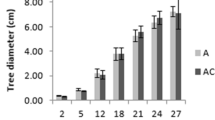Abstract
Brazil accounts for about 20% of the world production of cocoa, and about 95% of cocoa produced in Brazil is from the southeastern part of Bahia State. Traditionally, cacao is grown in monoculture (though under the shade of various other species). But various crop combinations involving cacao have recently been undertaken by the farmers with encouragement from Brazilian government.
As a part of the crop diversification programme in the traditional cacao growing areas and their surroundings, extensive areas are being planted to other plantation crops, mainly clove and rubber and, to some extent, coconut too. Crop combinations have been adopted in some of these new plantings and cacao is an important component of most of such combinations. Whereas several other crops are combined with clove trees, cacao is usually the only species grown with mature rubber trees. Young rubber trees are, however, interplanted with a number of other species. Productive coconut areas are found mostly in sandy soils along the coast so that there is little intercropping. However, scattered farms are found where coconuts are underplanted with guarana, black pepper, cacao, cashew, etc. as done commonly in other parts of Northeast Brazil.
Similar content being viewed by others
References
EMBRAPA (1982) Levantamento de Plantios mistos na colonia agricola de Tome-Acu, Para. Empresa Brasileira de Pesquisa Agropecuaria, Centro de Pesquisa Agropecuaria di Tropico Umido. Belem.
Hardy E (1961) Manual de Cacao. IICA, Turrialba, Costa Rica
Johnson D V and Nair P K R (1985) Perennial crop-based agroforestry systems in Northeast Brazil. Agroforestry Systems 2:281–292.
Liyanage M de S, Tejwani K G and Nair P K R (1984) Intercropping under coconuts in Sri Lanka. Agroforestry Systems 2:215–228
Nair P K R (1979) Intensive Multiple Cropping with coconuts in India. Principles, Programmes and Prospects. Verlag Paul Parey, Berlin (West)
Nair P K R (1982) Agroforestry: a sustainable land use system for the fragile ecosystems in the tropics. Malayan Nat J 35:109–123
Nair P K R (1983) Agroforestry with coconuts and other tropical plantation crops. In: Huxley P A (ed) Plant Research and Agroforestry, pp 79–102. ICRAF, Nairobi
Nair P K R (1984) Fruit Trees in Agroforestry. Working Paper. Environment and Policy Inst, East-West Center, Honolulu, Hawaii
Pushparajah E and Weng W P (1970) Cultivation of groundnuts and maize as intercrops in rubber. In: Blencowe E W and Blencowe J J (ed) Crop Diversification in Malaysia, pp. 53–65. Rubber Res Inst Malaysia, Kuala Lumpur
Wan Embong W M (1976) The concept and potentials of intergrated farming with rubber. Proc. Seminar Integration of Animals with Plantation Crops, pp. 49–60. Rubber Res Inst Malaysia, Kuala Lumpur
Author information
Authors and Affiliations
Rights and permissions
About this article
Cite this article
Alvim, R., Nair, P.K.R. Combination of cacao with other plantation crops: an agroforestry system in Southeast Bahia, Brazil. Agroforest Syst 4, 3–15 (1986). https://doi.org/10.1007/BF01834698
Issue Date:
DOI: https://doi.org/10.1007/BF01834698




